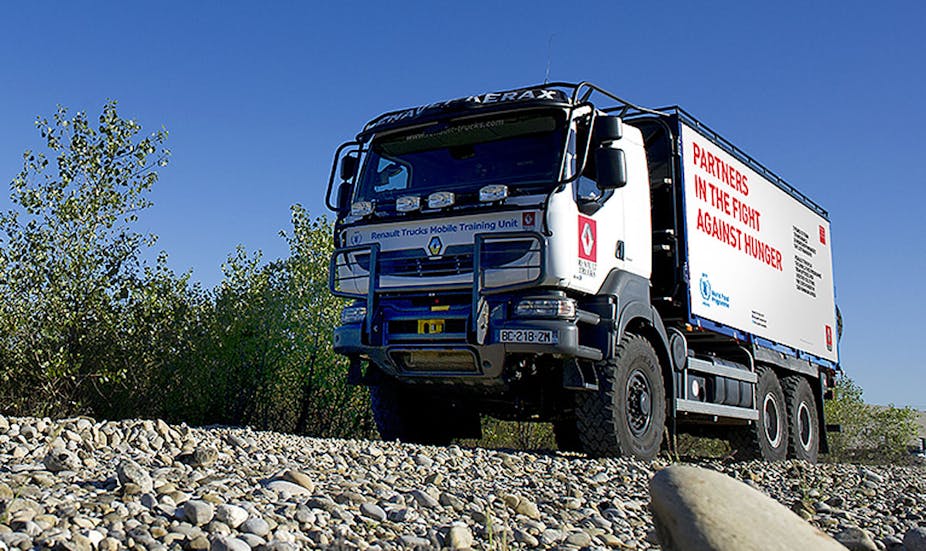Is corporate volunteering a simple public relations (PR) gimmick? Not necessarily. If done effectively, it presents a strategic tool for companies to better cope with the ongoing demographic shifts and manage their talent. Our pilot study of five European companies suggests that companies increasingly use corporate volunteering programs to attract millennials, boost their employees’ energy along longer working lives, and facilitate transitions toward retirement and continued social commitment.
Corporate volunteering – what is it?
Corporate volunteering relates to the corporate sponsoring and subsidizing of employees’ efforts to perform community service. For example, the Société Générale grants their employees 24 hours paid volunteering time per year to support their own charities or get involved in workshops, ongoing mentorship, and school programs. Other programs span several weeks and may be tied to long-standing partnerships. For example, Renault Trucks supports the World Food Program (WFP) and deploys corporate volunteers to train local WFP teams in Africa on truck maintenance and fleet and workshop management. Corporate volunteering can hence take many forms, yet builds on three features:
It involves the corporate contribution of employees’ time and skills to community service rather than passive monetary donations.
-
It is planned as opposed to spontaneous acts of helping.
It is implemented in collaboration with a volunteer organization (e.g. a charitable, community, or non-profit organization).
New relevance in the context of aging societies?
The idea of corporate volunteering originates from the U.S. where it emerged in the early 1900s. Today, it has become a common practice for companies especially in Europe and North America. For example, over 90% of Fortune 500 companies report to run employee volunteering programs. Over the years, corporate volunteering has turned from being ridiculed as PR gimmick toward becoming a strategic human resource management tool. Hiring, motivating, training, and retaining top talent is a critical foundation of high-performing companies – especially at times when more employees reach retirement than qualified young people enter the job market.
Competition to attract the millennials is therefore particularly fierce – a generation characterized as well educated, highly connected, multilingual, and increasingly caring about social causes and corporate values. To help attract this target group and show alignment with social expectations, companies such as AXA have set up programs that allow employees under 35 to commit to a humanitarian project that aligns with their envisioned career path. Participants often describe their program experience as energy-boosting, while also strengthening the bonds with their employer. Program managers we interviewed highlighted that many of the participants “come back with a fresh view and renewed enthusiasm.” Similarly, they considered volunteering as an “intellectual and emotional stimulator,” “pushing employee commitment,” and as promoting “gratefulness to be part of the company.”
Overall, “the employees get out of their comfort zone and daily routine, which is sometimes an eye-opener.” By interacting on a social cause, volunteers may sharpen their soft skills and emotional intelligence, including listening skills, pedagogical skills, empathy, adaptability, creativity, and stress management. In turn, the programs may benefit from the employees’ unique business expertise. For example, in cooperation with the United Nations Office for the Coordination of Humanitarian Affairs, the Deutsche Post DHL Group has established a global network of over 400 trained employees who volunteer to be a part of the Disaster Response Teams (DRTs). When called upon by the United Nations, the DRTs support disaster-site airports with various logistics responsibilities, including conducting inventory and making sure that the incoming supplies are received by the appropriate relief organizations.

Finally, and particularly interesting at a time where baby boomers are coming close to retirement, corporate volunteering may help companies incentivize and guide employees in their transition toward retirement. For example, AXA offers their employees the opportunity to participate in a paid 6-36 months program and work for an association or charity starting up to three years before retirement. In fact, many of the “young-old” aim to use their retirement for increased social engagement. Volunteering programs here offer “an easier, much softer transition toward retirement in which the employees keep their professional reference points while moving toward the new, social environment” as an interviewee explained.
Getting it right
An important learning among the companies, however, is that these benefits require a lot of resources and work to materialize. Whether anchored in the human resources, corporate responsibility, or work council team, a solid program management has to be set up to craft promising initiatives, share program news internally and externally, coach and support the employees before, during, and after their deployment, and engage in strategic program evaluation. This is critical to avoid that employees feel “lost” during their deployment and to ensure that they identify and positively embrace development opportunities. Further, it’s about nurturing close relationships with the partnering organizations, so as to align expectations and anticipate challenges. Hence, it is hard work and intriguing opportunities that shift corporate volunteering from a PR issue toward becoming an appreciated human resource management tool.
The research team included Elisa Barrouillet, Charlotte Jammes, and Pauline Lemée.

